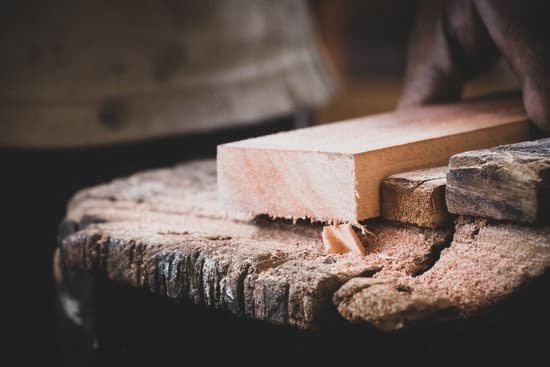Woodworking is a craft that requires precision, stability, and control over the materials being worked on. A crucial tool in any woodworker’s arsenal is a vice. So, what is a vice used for in woodwork? In woodworking, a vice serves as a vital tool for holding, clamping, and securing workpieces firmly in place during various tasks. This ensures accuracy and safety while working with wood.
Vices come in different types such as bench vices, hand vices, and engineer vices. Each type offers unique features tailored to specific woodworking needs. The right vice can help you efficiently tackle projects from simple repairs to intricate furniture making. Understanding the different types of vices available will guide you in selecting the most suitable one for your woodworking projects.
A vice plays a significant role in woodworking by providing stability and support for workpieces. Whether you are sawing, chiseling, planing, or sanding, a good quality vice can make all the difference in achieving precise results. As we delve deeper into the functions of a vice in woodworking and how to choose the right one for your projects, you will gain valuable insights on maximizing its utility and ensuring smooth woodworking operations.
What Is a Vice
A woodworking vice, commonly known as a woodworking vise in the United States, is an essential tool for any woodworker. It is a mechanical device used to securely hold, clamp, and stabilize workpieces during various woodworking tasks. Vices come in different types and configurations, each designed for specific applications in woodworking. The most common types of vices used in woodwork include bench vises, front vises, tail vises, shoulder vises, and leg vises.
Bench vises are typically mounted on a workbench and feature jaws that can be tightened or loosened by turning a handle. Front vises are often found at the front of the workbench and are ideal for holding long boards or panels. Tail vises are located at the end of a workbench and provide support for longer workpieces. Shoulder vises are used for securing narrow stock, while leg vises attach to the leg of a workbench for additional stability.
Each type of vice has its unique advantages and functions depending on the woodworking project at hand. For example, bench vises are versatile and can accommodate a wide range of materials and sizes, making them suitable for various tasks such as sawing, planing, drilling, and sanding.
Tail vises are particularly useful for joinery work where precision is required to ensure accurate cuts and joints. Understanding the differences between these vices will help woodworkers choose the right tool for their specific needs.
Functions of a Vice in Woodworking
A vice is an essential tool in woodworking, providing the stability and grip needed to work on various projects. The primary function of a vice in woodworking is to hold, clamp, and secure workpieces firmly in place. This enables woodworkers to saw, drill, chisel, plane, and perform other tasks with precision and safety. Without a vice, it would be challenging to work on intricate woodworking projects that require stability and accuracy.
There are different types of vices used in woodworking, including bench vises, quick-release vises, pipe vises, and machinist’s vises. Each type has specific features that cater to different needs and preferences of woodworkers. Bench vises are commonly used for general woodworking tasks due to their versatility and ease of use. Quick-release vises allow for rapid adjustment of the clamping pressure, making them ideal for quick changes during projects.
One of the key advantages of using a vice in woodworking is that it provides a secure platform for working with both large and small workpieces. A vice ensures that the workpiece remains stable while allowing the woodworker to apply precise cuts or shaping techniques without worrying about slippage or movement. Additionally, vices help in minimizing the risk of injuries by holding the workpiece securely in place throughout the woodworking process.
| Types of Vices | Main Features |
|---|---|
| Bench Vises | Versatile and easy to use for general woodworking tasks |
| Quick-Release Vises | Rapid adjustment of clamping pressure for quick changes during projects |
| Pipe Vises | Designed specifically for pipe threading and fitting tasks |
How to Choose the Right Vice for Your Woodworking Projects
When selecting the right vice for your woodworking projects, there are several crucial factors to consider that can make a significant impact on the quality of your work. One key consideration is the type of material you will be working with.
Different vices are designed to handle specific materials such as wood, metal, or plastic. For woodworking specifically, a woodworking vice is recommended as it typically has wider jaws and a more robust construction to withstand the pressures exerted during woodworking tasks.
Another important factor to keep in mind when choosing a vice is the size of your workspace. If you have limited space, opting for a compact bench vice may be more practical than a larger standing vice. Additionally, consider the size of the workpieces you will be handling regularly. Make sure the vice you choose has jaws wide enough and capable of holding your typical workpiece sizes securely in place.
Furthermore, think about the versatility and adjustability of the vice. Some vices come with swivel bases or quick-release features that can make your work more efficient and convenient. Think about how these additional features may benefit your specific woodworking projects and workflow. By carefully considering these factors, you can select a vice that not only meets your current needs but also has room for growth as you take on more complex woodworking projects in the future.
| Factor to Consider | Description |
|---|---|
| Material Compatibility | Choose a vice designed for handling wood for optimal performance. |
| Workspace Size | Consider the dimensions of your workspace when selecting between different types of vices. |
| Versatility and Adjustability | Look for additional features like swivel bases or quick-release mechanisms to enhance efficiency. |
Installing and Setting Up a Vice in Your Workspace
When it comes to woodworking, having a vice in your workspace is essential for holding, clamping, and securing workpieces. But knowing how to install and set up a vice properly is just as important. In this step-by-step guide, we will walk you through the process of setting up a vice in your woodworking area.
Choose the Right Location
Before installing your vice, it’s crucial to select the right location for it in your workshop. Make sure the surface where you plan to mount the vice is sturdy and can support its weight. Consider the height at which you want to place the vice to ensure comfortable working conditions.
Marking and Positioning
Once you have chosen the location for your vice, mark the position where you want to mount it on your workbench or table. Use a level to ensure that the vice will be installed straight and even. Position the vice so that it allows for easy access and manipulation while working on your projects.
Mounting the Vice
Now it’s time to actually mount the vice onto your work surface. Depending on the type of vice you have – whether it’s a front vise or a tail vise – follow the manufacturer’s instructions for installation. Typically, this involves attaching the base of the vice securely to your workbench using screws or bolts.
By following these steps and ensuring proper installation of your woodworking vice, you can make sure that it functions effectively and safely in your workspace. Remember that a well-installed and set-up vice will not only enhance your woodworking experience but also contribute to better precision and efficiency in your projects.
Safety Tips When Using a Vice in Woodworking
Woodworking can be a rewarding and fulfilling hobby or profession, but it also comes with inherent risks if proper safety precautions are not followed. One essential tool in woodworking that requires careful handling is a vice. A vice is used for holding and securing workpieces during various woodworking tasks, ensuring precision and stability. However, if not used correctly, it can pose safety hazards such as pinching fingers, slipping workpieces, or even accidents due to improper installation.
To avoid any mishaps while using a vice in woodworking, here are some important safety tips to keep in mind:
- Always make sure the vice is securely attached to a stable workbench or table before use. A loose or unstable vice can lead to unexpected movements and potentially dangerous situations.
- When clamping a workpiece in the vice, ensure that it is properly positioned and centered within the jaws. This will prevent uneven pressure distribution that could cause the piece to slip or shift during work.
- Use appropriate protective gear such as gloves and safety goggles when working with a vice. Splinters, flying debris, or accidental slips can pose real dangers to your hands and eyes.
By following these safety tips when using a vice in woodworking, you can protect yourself from potential accidents and injuries, allowing you to focus on your projects with peace of mind. Remember that safety should always be a top priority in any woodworking activity to ensure a safe and enjoyable experience.
Maintenance and Care of a Vice
A vice in woodworking is a crucial tool that aids in holding, clamping, and securing workpieces during various tasks. To ensure its longevity and optimal performance, proper maintenance and care are essential. Neglecting the upkeep of your vice can result in reduced effectiveness and potential safety hazards. Here are some key tips on how to maintain and care for your vice:
- Regular Cleaning: Dust, debris, and wood shavings can accumulate in the jaws and mechanisms of the vice over time. It is important to regularly clean these components to prevent any build-up that may affect its functionality. Use a brush or compressed air to remove any particles.
- Lubrication: Proper lubrication of the moving parts is vital to ensure smooth operation of the vice. Apply a small amount of lubricant, such as machine oil or grease, to the screw threads, sliding surfaces, and pivot points. This will help reduce friction and wear on the components.
- Inspection: Periodically inspect your vice for any signs of wear, damage, or misalignment. Check for loose screws or bolts that may need tightening, as well as any cracks or bends in the jaws. Addressing these issues promptly can prevent further damage and maintain the overall integrity of the tool.
In addition to regular maintenance practices, proper storage of your vice is also essential for preserving its condition. Store it in a dry environment away from excessive moisture or direct sunlight to prevent rust or corrosion. Covering it when not in use can also help protect it from dust and other contaminants.
By following these maintenance guidelines and caring for your vice properly, you can prolong its lifespan and ensure reliable performance throughout your woodworking projects. Remember that a well-maintained vice not only enhances efficiency but also contributes to a safer working environment.
Creative Uses of a Vice in Woodworking Projects
Woodworking vices are essential tools for any woodworker, not only for their traditional clamping and securing functions but also for their versatility in various woodworking projects. While vices are commonly used for holding workpieces in place, there are several creative ways to maximize their utility in woodworking projects.
Angled Work
One creative use of a vice in woodworking projects is holding angled workpieces securely in place. Many vices come with features that allow the jaws to be adjusted at different angles, making it easier to work on pieces that require specific positioning. This is especially useful when working on projects like picture frames or furniture legs that have angled cuts.
Joinery Work
Another creative use of a vice is for joinery work, such as dovetail joints or mortise and tenon joinery. By securely clamping the workpiece in the vice, woodworkers can ensure precision and accuracy when cutting and chiseling the joints. Vices provide stability and support during these intricate processes, resulting in seamless and professional-looking joints.
Assembly Work
In addition to holding individual pieces together, vices can also be used for assembly work in larger woodworking projects. By clamping multiple components together using a vice, woodworkers can accurately align and secure them before final assembly. This ensures that all parts fit together seamlessly, reducing errors and facilitating a smoother construction process.
By exploring these creative uses of a vice in woodworking projects, woodworkers can enhance their craftsmanship and efficiency in various tasks. Whether it’s handling angled workpieces, facilitating joinery tasks, or aiding in assembly work, vices play a crucial role in achieving professional results in woodworking projects. With proper knowledge of how to leverage the capabilities of a vice, woodworkers can elevate their craft to new heights while enjoying the practical benefits provided by this indispensable tool.
Conclusion
In conclusion, a vice is an essential tool in woodworking that serves various functions crucial to the success of a project. From holding pieces firmly in place to providing stability for precise cuts and shaping, vices play a significant role in ensuring efficiency and accuracy in woodworking tasks. Whether you are a beginner or a seasoned woodworker, having the right vice can make a world of difference in the quality of your work.
When considering what is a vice used for in woodworking, it becomes apparent that its versatility extends beyond just securing workpieces. The different types of vices available cater to specific needs, such as holding irregularly shaped objects or providing additional support for intricate detailing. By understanding the functions and features of various vices, craftsmen can select the most suitable one for their particular projects.
In essence, investing in a high-quality vice and taking proper care of it can greatly enhance your woodworking experience. By following safety guidelines, maintaining your vice regularly, and exploring creative ways to maximize its utility, you can elevate your craftsmanship and achieve excellent results in your woodworking endeavors. So, whether you’re assembling furniture, constructing cabinets, or working on smaller DIY projects, a reliable vice is sure to be an indispensable ally in your workshop.
Frequently Asked Questions
What Is a Woodworking Vise Used For?
A woodworking vise is primarily used to hold wood securely in place while working on it. It provides stability and allows for precise cutting, drilling, sanding, or any other woodworking tasks that require a steady hand and support.
What Do You Use a Vice For?
A vice, whether woodworking or metalworking, is a tool designed to hold objects firmly in place. It can be used for a variety of tasks such as cutting, filing, sawing, bending, shaping, or even assembling different parts together. The vice’s primary function is to secure the workpiece during these operations.
What Is a Vise Used in Carpentry?
In carpentry, a vise is commonly used to hold wood pieces together firmly during glue-ups or clamping joints while the adhesive dries. This ensures that the pieces are held securely in place and helps create strong bonds between them. Additionally, vises can also be used for tasks like planing, sawing, chiseling, or carving wood with stability and precision.

Hi everyone! I’m a woodworker and blogger, and this is my woodworking blog. In my blog, I share tips and tricks for woodworkers of all skill levels, as well as project ideas that you can try yourself.





